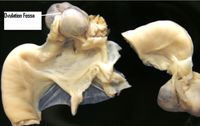Difference between revisions of "Female Reproductive Tract - Horse Anatomy"
| Line 11: | Line 11: | ||
Contains [[Follicles_- Anatomy & Physiology|Follicles]] in various stages of development as well as the [[Corpus Luteum_- Anatomy & Physiology|Corpus Luteum]] (includes Corpus Haemorrhagicum and Corpus Albicans). The cortex reaches the surface of the ovary at the ovulation fossa, a deep indentation at the free margin. This is where mature follicles rupture in ovulation, as opposed to at various points on the surface in other domestic mammals. [[Follicles_- Anatomy & Physiology|Follicles]] can be identified by transrectal palpation, but [[Corpus Luteum_- Anatomy & Physiology|Corpora Lutea]] cannot. Identification of [[Corpus Luteum_- Anatomy & Physiology|Corpora Lutea]] requires ultrasonography. | Contains [[Follicles_- Anatomy & Physiology|Follicles]] in various stages of development as well as the [[Corpus Luteum_- Anatomy & Physiology|Corpus Luteum]] (includes Corpus Haemorrhagicum and Corpus Albicans). The cortex reaches the surface of the ovary at the ovulation fossa, a deep indentation at the free margin. This is where mature follicles rupture in ovulation, as opposed to at various points on the surface in other domestic mammals. [[Follicles_- Anatomy & Physiology|Follicles]] can be identified by transrectal palpation, but [[Corpus Luteum_- Anatomy & Physiology|Corpora Lutea]] cannot. Identification of [[Corpus Luteum_- Anatomy & Physiology|Corpora Lutea]] requires ultrasonography. | ||
===Medulla=== | ===Medulla=== | ||
| − | The Medulla is made up of dense connective tissue. This is where all of the lymphatics, nerves and vasculature of the | + | The Medulla is made up of dense connective tissue. This is where all of the lymphatics, nerves and vasculature of the ovary are found. |
==Oviducts== | ==Oviducts== | ||
Revision as of 14:44, 26 November 2012
| This article is still under construction. |
Ovaries
The ovary is the female Gonad homologous to the male Testes.The structures found within the ovary are undergoing constant changes throughout the oestrus cycle from the Follicles containing Oocytes, to the formation of Corpus Haemorrhagicum, Corpus Luteum, and finally Corpus Albicans. The ovaries of the mare are two kidney-shaped structures situated ventral to the 4th and 5th lumbar vertebrae, supported by the mesovarium. During the non-breeding season they measure 2-4cm in length and 2-3cm in width. During the sexually active stage, they are 6-8cm in length and 3-4cm in width.
In the mare, the structure of the ovary is reversed compared to other species. The cortex is in the centre and is enclosed by a dense, richly vascularised connective tissue layer, which is analagous to the medulla of other domestic mammals.
Tunica Albiguinea
The connective tissue layer covering the ovarian cortex. The whole ovary is contained within the tunica albiguinea except the ovulation fossa. Overlying this structure is a single layered germinal epithelium.
Cortex
Contains Follicles in various stages of development as well as the Corpus Luteum (includes Corpus Haemorrhagicum and Corpus Albicans). The cortex reaches the surface of the ovary at the ovulation fossa, a deep indentation at the free margin. This is where mature follicles rupture in ovulation, as opposed to at various points on the surface in other domestic mammals. Follicles can be identified by transrectal palpation, but Corpora Lutea cannot. Identification of Corpora Lutea requires ultrasonography.
Medulla
The Medulla is made up of dense connective tissue. This is where all of the lymphatics, nerves and vasculature of the ovary are found.
